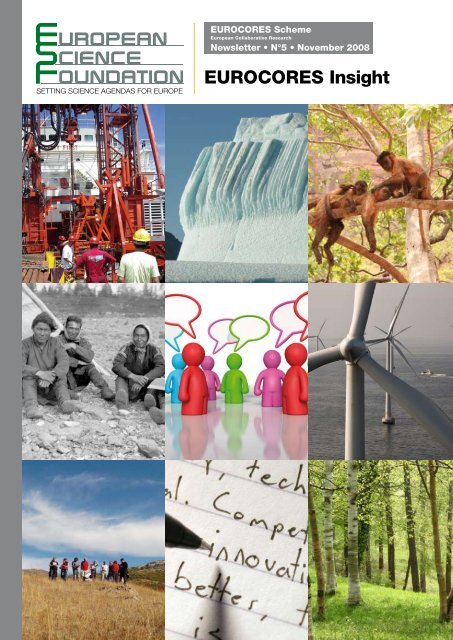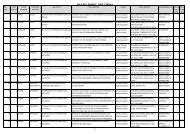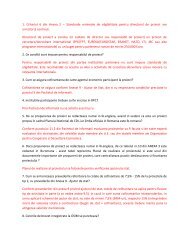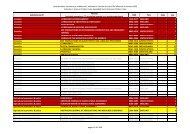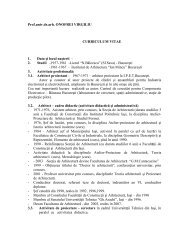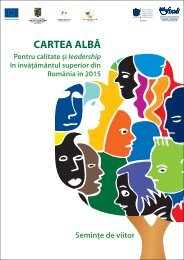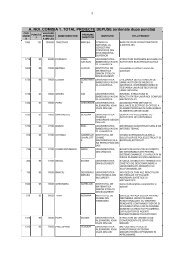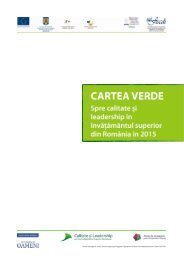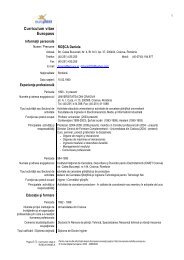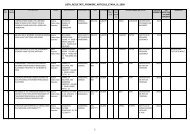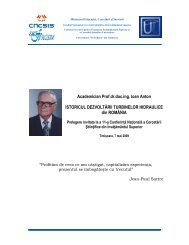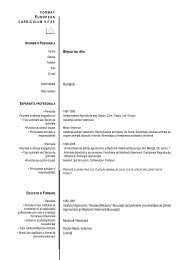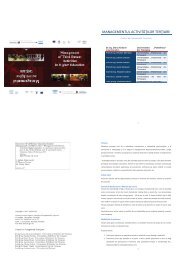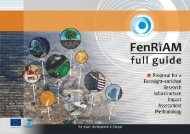EUROCORES Insight - European Science Foundation
EUROCORES Insight - European Science Foundation
EUROCORES Insight - European Science Foundation
You also want an ePaper? Increase the reach of your titles
YUMPU automatically turns print PDFs into web optimized ePapers that Google loves.
<strong>EUROCORES</strong> Scheme<br />
<strong>European</strong> Collaborative Research<br />
Newsletter • N°5 • November 2008<br />
SETTING SCIENCE AGENDAS FOR EUROPE<br />
<strong>EUROCORES</strong> <strong>Insight</strong>
Editorial<br />
Index<br />
Editorial 2<br />
News<br />
New <strong>EUROCORES</strong> Themes 3<br />
Now It’s Ours! 3<br />
<strong>EUROCORES</strong> Scheme Workshop 4<br />
ESF Collaborative Research Tool Kit 4<br />
EuroCLIMATE DVD Out 5<br />
Understanding Europe’s Topography 5<br />
How My Country Influences<br />
My Behaviour 7<br />
Q and A<br />
Jelle Bijma on the Achievements<br />
of the <strong>EUROCORES</strong> Programme<br />
EuroCLIMATE 8<br />
Features<br />
Europe Cores in <strong>EUROCORES</strong><br />
– Ocean Drilling in EuroMARC 9<br />
Prizes Recognise Young Scholars<br />
in Consciousness Research 11<br />
Quantum Measurements, Precisely 13<br />
RNA Emerges from DNA’s Shadow 15<br />
Past Events<br />
The Amazing Quantum World<br />
of Ultra Cold Matter 16<br />
Schoolteachers’ Workshop<br />
on the Carbon Cycle 18<br />
S3T Focuses on Engineering<br />
Challenges of Sustainable Energy<br />
Use and Production 19<br />
BOREAS Workshop “Population<br />
Dynamics in the Circumpolar North” 20<br />
SONS Double Act: Scientists get<br />
together in two workshops 21<br />
TECT Summer School “Tools of the<br />
Trade in Cooperation Research” 22<br />
Upcoming Events 23<br />
Dear reader,<br />
I wish you a very warm welcome to the new <strong>EUROCORES</strong> INSIGHT No. 5.<br />
Activities and developments over the last months are showing that the <strong>EUROCORES</strong><br />
Scheme is going strong. Six new programme proposals have been developed out<br />
of the 38 submitted <strong>EUROCORES</strong> themes proposals, and we hope that many of<br />
them will be published in a few weeks. All these proposals show the high interest<br />
of the scientific community in and across all scientific domains to work together at<br />
a <strong>European</strong> level.<br />
The publication of a second set of <strong>EUROCORES</strong> Calls for proposals this year marks<br />
one of the other achievements of this year, namely the implementation of the revised<br />
<strong>EUROCORES</strong> procedures which shorten the <strong>EUROCORES</strong> process by another<br />
three months.<br />
Having achieved all this, now a number changes will take place for the <strong>EUROCORES</strong><br />
Scheme from 2009 onwards. One major change is the end of the support of the<br />
<strong>EUROCORES</strong> Scheme by the EC contract and the successful transfer to a fully ESF<br />
Member Organisation owned <strong>EUROCORES</strong> Scheme.<br />
This new start will also be reflected in having new faces at the <strong>EUROCORES</strong><br />
Scheme Office. After almost ten years at the ESF and more than five years of very<br />
challenging and interesting work for the <strong>EUROCORES</strong> Scheme and working in<br />
close collaboration with many of you in the National Funding Organisations, I will<br />
leave the ESF. Stephanie Pery, my colleague in the Scheme Office will take up<br />
a new opportunity in the PESC Unit of the ESF, and finally also John Marks, our<br />
Director for <strong>Science</strong> and Strategy, will leave the ESF at the end of the year. The new<br />
<strong>EUROCORES</strong> Scheme Coordinator will be Farzam Ranjbaran who is very familiar<br />
with the Scheme, having coordinated <strong>EUROCORES</strong> programmes for more than<br />
three years.<br />
We will use this issue of <strong>EUROCORES</strong> INSIGHT to provide you with the details<br />
of the most important developments in the second half of 2008 and the most<br />
interesting news and science stories from our <strong>EUROCORES</strong> Programmes. The<br />
latter encompass, for example, an insight into the exciting ocean drilling conducted<br />
in the EuroMARC programme. We can also read about about RNA, the transporter<br />
of genetic information within the cell, as well as about the CNCC Essay Prize, which<br />
recognises the emerging talents in the field of consciousness research. Moreover,<br />
both HumVIB, which is the first <strong>EUROCORES</strong> programme in the social sciences,<br />
and TOPO-EUROPE – the biggest <strong>EUROCORES</strong> programme so far – are featured.<br />
Finally, a number of programmes are reporting on their past networking events,<br />
which even include outreach activities like a schoolteachers’ workshop on the global<br />
carbon cycle co-organised by EuroCLIMATE.<br />
I hope you will enjoy this new issue of <strong>EUROCORES</strong> INSIGHT and wish you all the<br />
best for the future.<br />
Svenje Mehlert, Senior <strong>Science</strong> Officer, <strong>EUROCORES</strong> Scheme Coordination<br />
smehlert@esf.org<br />
<strong>EUROCORES</strong> <strong>Insight</strong><br />
Editor: Angela Michiko Hama mhama@esf.org • Editorial Board: Antonella Di Trapani aditrapani@esf.org - Inge Jonckheere ijonckheere@esf.org - Svenje Mehlert smehlert@esf.org<br />
Cover picture: © IODP - H. Oerter - Noemi Spagnoletti - A.P. Kirilovich Source KKKM 7930-1-02-05 - iStockphoto -<br />
Siemens press picture - ESF - Jacqueline McLelland<br />
<strong>EUROCORES</strong> <strong>Insight</strong> 2
News<br />
New <strong>EUROCORES</strong> Themes Selected<br />
The 2008 Call for <strong>EUROCORES</strong> themes, which was published in March 2008 with a deadline<br />
of 2 June 2008, received 38 proposals for new <strong>EUROCORES</strong> themes. Following a thorough<br />
peer review process involving the ESF Standing Committees, the ESF <strong>Science</strong> Advisory<br />
Board and the ESF Governing Council, the following six new themes were selected to be<br />
developed into new <strong>EUROCORES</strong> programmes:<br />
• Maximizing the Impact of Graphene Research in<br />
<strong>Science</strong> and Innovation (EuroGRAPHENE)<br />
• Ecological and evolutionary functional genomics<br />
(EuroEEFG)<br />
• Synthetic Biology: Engineering Complex Biological<br />
Systems (EuroSYNBIO)<br />
• <strong>European</strong> Comparisons in Regional Cohesion,<br />
Dynamics and Expressions (EuroCORECODE)<br />
• Origin of the elements and nuclear history of the<br />
Universe (EuroGENESIS)<br />
• <strong>European</strong> collaborative research on cooling in<br />
acute ischemic stroke (EuroCOOLS)<br />
The decision on the viability of the six new <strong>EUROCORES</strong><br />
programmes will be taken in mid December and the new<br />
Calls for proposals are envisaged to be published on 19<br />
December 2008.<br />
In addition, the ESF Governing Council decided to<br />
develop the proposal “Bio-inspired Engineering of<br />
Sensors, Actuators & Systems (EuroBioSAS)”, which<br />
was originally proposed to be a pilot case for a TOP-<br />
CORES, into an additional <strong>EUROCORES</strong> programme.<br />
For more information,<br />
see www.esf.org/eurocores<br />
Now It’s Ours!<br />
After more than five years support from the <strong>European</strong><br />
Commission, the <strong>EUROCORES</strong> Scheme will, as of<br />
January 2009, go into full ownership of the ESF<br />
Member Organisations. The support by the <strong>European</strong><br />
Commission has allowed the ESF to develop and<br />
establish the <strong>EUROCORES</strong> Scheme as a well working<br />
instrument for collaborative research programmes,<br />
including the development of calls for proposals with<br />
subsequent one or two-stage peer reviews, support<br />
for funding negotiations and subsequent networking<br />
and dissemination of the funded projects. Thus, added<br />
value for the science community and the National<br />
Funding Organisations involved has been created.<br />
With the transition of the support for the coordination<br />
and networking from the Commission contract to the<br />
support by the National Funding Organisations funding<br />
projects within a given <strong>EUROCORES</strong> programme, the<br />
ESF Member Organisations and their partner research<br />
organisations in the <strong>EUROCORES</strong> programmes are<br />
taking full ownership of the <strong>EUROCORES</strong> Scheme.<br />
This is also reflected in the adoption of the new “Terms<br />
of Participation in the <strong>EUROCORES</strong> Scheme” which<br />
will be obligatory for the future participation in any of<br />
the new <strong>EUROCORES</strong> programme. These terms define<br />
new roles for the Management Committees in the<br />
running of the <strong>EUROCORES</strong> programme and establish<br />
the <strong>EUROCORES</strong> Scheme Management Committee,<br />
which formalises the role of the meetings of the<br />
National Funding Organisations at the <strong>EUROCORES</strong><br />
workshops and acknowledges the work achieved in<br />
these workshops over the past five years.<br />
<strong>EUROCORES</strong> <strong>Insight</strong> 3
News<br />
<strong>EUROCORES</strong> Scheme Workshop VI<br />
The sixth <strong>EUROCORES</strong> workshop held on 8 and 9<br />
September 2008 in Brussels was one of the most<br />
successful workshops of the <strong>EUROCORES</strong> Scheme. The<br />
workshop which was chaired by Marja Makarow, the ESF<br />
Chief Executive, brought together 37 representatives from<br />
32 different National Funding Organisations including the<br />
US-NSF, as well as the <strong>European</strong> Commission.<br />
The workshop was characterised by lively discussion<br />
of the participants. It reached conclusions on the major<br />
aspects of the <strong>EUROCORES</strong> Scheme. This include the<br />
level of contribution to the coordination and networking<br />
costs for the <strong>EUROCORES</strong> Programmes, the new<br />
definitions of roles in the decision making in the future<br />
scheme and a regular review of the new system.<br />
EuroCLIMATE<br />
The most important agreements are summarised in<br />
the new “Terms of participation in the <strong>EUROCORES</strong><br />
Scheme” which can be obtained from the ESF Office at<br />
www.esf.org/eurocores.<br />
EuroCLIMATE is an <strong>EUROCORES</strong> Programme<br />
from the <strong>European</strong> <strong>Science</strong> <strong>Foundation</strong> (ESF)<br />
that supports research addressing climate<br />
variability of the past, present and future<br />
and particularly its relationship to the global<br />
carbon cycle dynamics. The future climate<br />
and its variability are expected to differ greatly<br />
from the present and the recent past.<br />
The reconstruction of palaeoclimates offers<br />
the possibility to study a broad climatic<br />
diversity and to better understand the climate<br />
system. Such reconstruction of past climates<br />
further provides the possibility to assess<br />
the reliability and robustness of the models<br />
used for future climate change scenarios.<br />
EuroCLIMATE focuses both on reconstructing<br />
past climates using different well-dated and<br />
calibrated proxy records, and on modelling<br />
climate variations.<br />
It brings together leading <strong>European</strong> marine,<br />
terrestrial and ice-core communities on<br />
crosscutting issues that will advance our<br />
understanding of climate variability and<br />
underlying physical, chemical and biological<br />
processes involved. EuroCLIMATE involves<br />
more than 70 <strong>European</strong> scientists and their<br />
research teams throughout 9<br />
trans-national collaborative research projects,<br />
and provides a unique opportunity for the<br />
training of young researchers.<br />
This DVD provides a concise overview of some of the EuroCLIMATE activities and main achievements. Five<br />
EuroCLIMATE projects interested in marine markers, namely PaleoSalt, ISOTRACE, CHALLACEA, DECLAKES<br />
and MERF, are presented here. EuroCLIMATE also includes other important projects such as DECVEG,<br />
CASIOPEIA, TREE14, and RESOLuTION dealing with continental indicators and ice cores data.<br />
<strong>European</strong> <strong>Science</strong> <strong>Foundation</strong><br />
© 2008 ESF / Zcene<br />
www.esf.org / www.zcene.nl<br />
inlay ESF ZCENE3.indd 1<br />
© iStockphoto<br />
ESF Collaborative Research Tool Kit<br />
One of the successful spins-offs<br />
of the <strong>EUROCORES</strong> Scheme<br />
is the ESF Collaborative<br />
Research Tool Kit. The Tool<br />
Kit was developed from the<br />
<strong>EUROCORES</strong> experiences<br />
of running more than 30<br />
Calls for proposals but also<br />
from taking up experience<br />
gained in other ESF<br />
instruments such as ESF<br />
Research Networking<br />
Programmes, ESF<br />
Conferences, COST<br />
Action or EURYI<br />
Awards. The Tool Kit<br />
has been implemented for a first<br />
pilot application for the EUROPOLAR ERA-NET and the<br />
implementation and running of their POLARCLIMATE Call<br />
for proposals. This call for proposals brought together<br />
20 organisations from 18 countries and a total funding<br />
volume of about 10 Mio €. The call was published in<br />
September 2008 and received 38 pre-proposals which<br />
are currently being processed in a two-stage peer review.<br />
First funding for the selected projects is foreseen for the<br />
second half of 2009. Several more interested ERA-Nets<br />
are currently in discussion with the ESF Office for the<br />
further implementation of the Tool Kit.<br />
For more information,<br />
please contact the ESF Office<br />
at tool-kit@esf.org.<br />
4 <strong>EUROCORES</strong> <strong>Insight</strong>
News<br />
EuroCLIMATE<br />
SETTING SCIENCE AGENDAS FOR EUROPE<br />
EuroCLIMATE<br />
EuroCLIMATE is an <strong>EUROCORES</strong> Programme EuroCLIMATE focuses both on reconstructing<br />
from the <strong>European</strong> <strong>Science</strong> <strong>Foundation</strong> (ESF) past climates using different well-dated and<br />
that supports research addressing climate calibrated proxy records, and on modelling<br />
variability of the past, present and future climate variations.<br />
and particularly its relationship to the global It brings together leading <strong>European</strong> marine,<br />
carbon cycle dynamics. The future climate terrestrial and ice-core communities on<br />
and its variability are expected to differ greatly crosscutting issues that will advance our<br />
from the present and the recent past. understanding of climate variability and<br />
The reconstruction of palaeoclimates offers underlying physical, chemical and biological<br />
the possibility to study a broad climatic processes involved. EuroCLIMATE involves<br />
diversity and to better understand the climate more than 70 <strong>European</strong> scientists and their<br />
system. Such reconstruction of past climates research teams throughout 9<br />
further provides the possibility to assess trans-national collaborative research projects,<br />
the reliability and robustness of the models and provides a unique opportunity for the<br />
used for future climate change scenarios. training of young researchers.<br />
This DVD provides a concise overview of some of the EuroCLIMATE activities and main achievements. Five<br />
EuroCLIMATE projects interested in marine markers, namely PaleoSalt, ISOTRACE, CHALLACEA, DECLAKES<br />
and MERF, are presented here. EuroCLIMATE also includes other important projects such as DECVEG,<br />
CASIOPEIA, TREE14, and RESOLuTION dealing with continental indicators and ice cores data.<br />
<strong>European</strong> <strong>Science</strong> <strong>Foundation</strong><br />
EuroCLIMATE<br />
DVD Out!<br />
SETTING SCIENCE AGENDAS FOR EUROPE<br />
EuroCLIMATE<br />
For more information,<br />
see www.esf.org/euroclimate<br />
or contact Didier Hauglustaine<br />
at euroclimate@esf.org<br />
EuroCLIMATE Programme<br />
Coordinator<br />
25-8-2008 8:08:11<br />
© 2008 ESF / Zcene<br />
www.esf.org / www.zcene.nl<br />
inlay ESF ZCENE3.indd 1 25-8-2008 8:08:11<br />
Understanding Europe’s Topography<br />
The <strong>EUROCORES</strong> programme<br />
TOPO-EUROPE kicks off<br />
Europe’s shape is in a constant change: The Mediterranean<br />
basin is shrinking, the Alps are rising and pushing North, and<br />
Scandinavia is still rebounding after having been crushed by the<br />
weight of a thick and huge ice sheet in the ice ages. But what did<br />
Europe look like in the past, what are the processes controlling<br />
all these changes and what has the future in store for us? And<br />
how does the topography influence the climate of Europe on<br />
geological time scales?<br />
The <strong>EUROCORES</strong> programme TOPO-EUROPE (4-D Topography<br />
Evolution in Europe: Uplift, Subsidence and Sea Level Change)<br />
sets out to answer these questions and many more. So far the<br />
largest programme of the <strong>European</strong> Collaborative Research<br />
Scheme (<strong>EUROCORES</strong>) with 10 Collaborative Research Projects<br />
(CRPs) including 16 National Funding Organisations and an overall<br />
budget of approximately 15 million Euros, TOPO-EUROPE is a<br />
concerted action to observe and better understand the evolution<br />
of the continent in both space and time. The programme kicked<br />
off in El Escorial near Madrid in October 2008 during the fourth<br />
TOPO-EUROPE international workshop.<br />
The TOPO-EUROPE programme is part of a <strong>European</strong>-wide<br />
network of the same name. The network was born in the<br />
International Lithosphere Programme (ILP) and developed<br />
as a regional research coordinating committee for Europe.<br />
“<strong>EUROCORES</strong> TOPO-EUROPE provides an important stimulus<br />
for realising the ambitions of the TOPO-EUROPE initiative at large”<br />
said Professor Sierd Cloetingh of Vrije Universiteit Amsterdam,<br />
© GFZ Helmholtz Centre Potsdam<br />
Shape of the Earth’s Geoid after the EIGEN-05C – model<br />
<strong>EUROCORES</strong> <strong>Insight</strong> 5
News<br />
the Adriatic and assess the impacts of sea-level rise<br />
and concomitant risk of flooding case by case.<br />
© ESF<br />
Kai Rankenburg, former TOPO-EUROPE Programme Coordinator<br />
and Sierd, chair of TOPO-EUROPE’s scientific committee<br />
in El Escorial, Spain<br />
President of the ILP and initiator of both the network<br />
and the programme. “The idea is to bring different<br />
segments of the <strong>European</strong> community together from<br />
the fields of deep Earth and surface processes and<br />
for exactly that <strong>EUROCORES</strong> is a good instrument”<br />
continued Cloetingh. TOPO-EUROPE is also the<br />
natural successor of EuroMARGINS, a completed<br />
<strong>EUROCORES</strong> programme on continental margins.<br />
A selection of Europe’s manifold natural laboratories<br />
is under investigation, ranging from orogens like the<br />
Pyrenees and the Alps via the Anatolian Plateau to<br />
the Scandinavian upland and the Mediterranean. The<br />
science in TOPO-EUROPE covers a wide spectrum<br />
of topics: inter alia, Earth crust and mantle dynamics,<br />
source-to-sink relationships and sediment dynamics,<br />
plateau formation and plate-reorganisation.<br />
TOPO-EUROPE is highly interdisciplinary, pooling<br />
not only solid Earth experts but also coupling them<br />
with climate scientists. One of the programme’s<br />
Collaborative Research Projects called TOPO-ALPS,<br />
for example, attempts to unravel the topographic<br />
history of the Alps and its tectonic and climatic drivers.<br />
“One of the foci in the current TOPO-EUROPE is to<br />
find ways to bring climate in, to determine what role<br />
this plays in tectonic and geomorphic problems. This<br />
is a frontier of science, so I expect to see more and<br />
more of this type of project in the future” explained<br />
Professor Sean Willet, the project leader of TOPO-<br />
ALPS and a geologist at ETH Zurich, Switzerland.<br />
Another CRP called RESEL-GRACE looks<br />
into refining <strong>European</strong> sea level estimations by<br />
combining altimetry, tide gauges and other data with<br />
improved glacial isostatic adjustment modelling and<br />
tailored regional gravity field models that reflect the<br />
redistribution of water masses. “Most important now<br />
is to study the impacts of sea level rise and here<br />
hardly anything has been done” said Anny Cazenave<br />
of Centre National d’Etudes Spatiales (CNES) in<br />
Toulouse, France. “The rise, the sedimentology, the<br />
tectonics, ocean dynamics and climate need to<br />
be combined to develop models for the impacts”<br />
continued Cazenave, who is also a lead author<br />
of the Nobel prize-winning fourth IPCC report. In<br />
RESEL-GRACE, she will identify the most vulnerable<br />
ecosystems and economies such as the Nile Delta or<br />
There are further applied aspects of the research<br />
undertaken in TOPO-EUROPE, which renders the<br />
results enormously interesting for the geological<br />
surveys of Europe. “A number of issues like geothermal<br />
energy, seismic hazards and slope instabilities require<br />
a know-how that goes beyond the national borders<br />
of Europe” said Cloetingh. New concepts are being<br />
developed but need to be validated at the same time<br />
with an array of different types of data in order to<br />
reach a better geo-prediction that could eventually<br />
save lives and protect property.<br />
TOPO-EUROPE creates also new research<br />
opportunities by opening up 50 to 60 positions for<br />
young researchers. “If you don’t offer opportunities,<br />
young people will not go into our field as they will<br />
© ESF<br />
TOPO-EUROPE excursion in Spain’s Central Range as part of the 4th TOPO-EUROPE<br />
Workshop, October 2008<br />
have the impression that everything has been solved,<br />
that the field is classical” explained Cloetingh. With<br />
programmes like TOPO-EUROPE and by further<br />
modernising the science, a pool of researchers is<br />
created that is able to fill up the positions to become<br />
available in the years to come with the generation<br />
change. The interest in the Earth sciences is constantly<br />
increasing and statistics in terms of student, PhD<br />
and post-doc populations are promising. Even the<br />
proportion of women has reached 50 percent among<br />
students, which is a great success in a formerly<br />
extremely male-dominated discipline.<br />
Next to the collaborations within the <strong>EUROCORES</strong><br />
programme, a plentitude of synergies is envisaged<br />
since the programme is not a stand-alone. The<br />
TOPO-IBERIA Research Initiative and the EU EPOS-<br />
ESFRI programme will be important partners, and<br />
TOPO-EUROPE hopes to team up with the TOPO-<br />
Central Asia programme. The TOPO-EUROPE<br />
network is part of the ILP research agenda and<br />
hence paving the way for a global partnership in the<br />
Earth sciences.<br />
For more information, see<br />
w w w. e s f . o r g / t o p o e u ro p e<br />
or contact Didier Hauglustaine<br />
at topoeurope@esf.org<br />
TOPO-EUROPE Programme Coordinator<br />
6 <strong>EUROCORES</strong> <strong>Insight</strong>
News<br />
How My Country Influences My Behaviour<br />
HumVIB, the first EURO-<br />
CORES programme in the<br />
social sciences, kicks off<br />
Why do I cast my ballot on Election Day, or why do I<br />
choose to stay at home instead? What are the main<br />
factors influencing my decision? Human behaviour is not<br />
only determined at a personal level, but moulded by the<br />
social, political and economic context in each country and<br />
region. Differences in cultures, institutions, structures and<br />
practices help explain differing individual values, attitudes<br />
and behaviour across the population of Europe.<br />
The new <strong>EUROCORES</strong> programme HumVIB sets out to<br />
answer these issues at a <strong>European</strong> level by undertaking<br />
a “Cross-national and Multi-level Analysis of Human<br />
Values, Institutions and Behaviour”. HumVIB is the first ever<br />
<strong>EUROCORES</strong> programme in the social sciences and an<br />
ambitious attempt to integrate this hitherto fragmented field.<br />
”This is a major innovation in the social sciences and for the<br />
ESF” said Richard Sinnott, Professor of Political <strong>Science</strong><br />
at University College Dublin and the original proposer<br />
of the HumVIB theme. “The idea is to address a range<br />
of research questions using the strategy of connecting<br />
individual behaviour with the institutional context as the<br />
integrating device that unites the various components of the<br />
programme in a coherent whole” continued Sinnott.<br />
Sinnott’s brainchild has led to a fully-fledged programme<br />
consisting of six Collaborative Research Projects (CRPs)<br />
involving scientists from 15 countries. Under the umbrella<br />
of the common research strategy, the projects are looking<br />
into voter turnout and abstention, welfare attitudes and<br />
the influence of the environment on people’s happiness.<br />
Moreover, the issue of gender inequality is addressed, as<br />
well as the question of why political representatives often do<br />
not reflect the views of their constituencies. “Europe serves<br />
as an excellent natural laboratory for this kind of study due<br />
to its enormous cultural, social, political and economic<br />
diversity,” said Sinnott.<br />
The LIFETIMING CRP, for example, aims to explain variations<br />
in the views of <strong>European</strong>s on the organisation of the life<br />
course. The periods of life are in general predefined, but<br />
at what age a person is perceived as an “adult” or “old”<br />
depends on the cultural background and can vary by more<br />
than a decade! The timing of events in one’s life course, such<br />
as getting married or having children, is related to social<br />
norms, too. “We also want to find out to what extent people<br />
are really able to take initiative with regard to their own lives<br />
and consciously plan their future,” elaborated Professor<br />
Aat Liefbroer from Vrije Universiteit Amsterdam, the project<br />
leader of LIFETIMING and co-Chair with Richard Sinnott of<br />
HumVIB’s scientific committee. Showing that people might<br />
actually need to be facilitated in certain areas of structuring<br />
their lives could be a useful finding for policy-makers.<br />
Many of the results to be obtained are expected to feed into<br />
policy-making, thus linking theory and practice. Examining<br />
how institutional frameworks foster gender inequalities,<br />
resulting in underrepresentation of women in leadership<br />
roles as well as in higher poverty rates among women,<br />
can help in designing counter measures<br />
and eventually in bridging the gender<br />
gap. Similarly, voter turnout does matter,<br />
since stay-at-home citizens reduce the<br />
legitimacy of government. Understanding<br />
why people vote or abstain is a prerequisite<br />
for efficient voter mobilisation and ultimately<br />
for effective representation.<br />
Without the establishment of the Descartes<br />
Prize-winning <strong>European</strong> Social Survey<br />
(ESS), which originated in an ESF activity<br />
and is also co-funded by the ESF, HumVIB<br />
would simply not be possible. This recent<br />
and fundamentally pan-<strong>European</strong> effort in<br />
the <strong>European</strong> social sciences is based<br />
on rigorous sampling and measurement<br />
and, crucially in this context, on the use<br />
of representative within-country samples<br />
in a sufficiently large number of countries.<br />
Additionally, data collection for the ESS is<br />
not restricted to individual-level information,<br />
but includes systematically collected data<br />
on events and developments during the<br />
fieldwork period as well as on the contextual<br />
characteristics of the countries involved. All<br />
of HumVIB’s projects will work with data<br />
from the ESS and take into account the<br />
explicit standards for research design and<br />
data collection that the ESS has set.<br />
HumVIB is not a purely <strong>European</strong> endeavour<br />
but also encompasses North American<br />
scientists like Karen Jusko, assistant professor at Stanford<br />
University and one of the Principal Investigators in HumVIB’s<br />
VTAC project on voter turnout and abstention. “As I study<br />
developed democracies, the opportunity to develop a<br />
<strong>European</strong> network and work with the experts in each<br />
country is especially important to me” explained Jusko.<br />
“The National <strong>Science</strong> <strong>Foundation</strong> (NSF) is enormously<br />
supportive of HumVIB and has even encouraged me<br />
to incorporate extended visits at the institutions of my<br />
<strong>European</strong> collaborators into my research plans” continued<br />
Jusko.<br />
With the HumVIB programme having just kicked off in a first<br />
meeting at University College Dublin (UCD) last October, the<br />
networking phase typical for all <strong>EUROCORES</strong> programmes<br />
has started. Apart from workshops and meetings for all<br />
HumVIB researchers, activities for young scientists such as<br />
summer schools are envisioned. “It’s especially important<br />
for the young people to receive training and build up their<br />
own network” said Liefbroer, who will play an active role in<br />
organising events for the younger generation. Furthermore,<br />
the HumVIB members will not only collaborate within the<br />
programme, but plan on linking up with important <strong>European</strong><br />
data centres like the <strong>European</strong> Data Centre for Work and<br />
Welfare and other initiatives.<br />
F o r m o re i n f o r m a t i o n , s e e w w w. e s f . o r g / h u m v i b<br />
or contact Sarah Moore at humvib@esf.org<br />
HumVIB Programme Coordinator<br />
© ESF © ESF<br />
Aat Liefbroer and Richard Sinnott, the two<br />
co-chairs of HumVIB’s scientific committee<br />
<strong>EUROCORES</strong> <strong>Insight</strong> 7
Q and A<br />
Jelle Bijma on the Achievements of the <strong>EUROCORES</strong><br />
Programme EuroCLIMATE<br />
© ESF/Zcene<br />
Jelle Bijma in the new EuroCLIMATE DVD<br />
Professor Jelle Bijma, chair of the scientific<br />
committee of the <strong>EUROCORES</strong> programme<br />
EuroCLIMATE (Climate Variability & Past,<br />
Present & Future Carbon Cycle) speaks<br />
about the outcomes and benefits of the<br />
programme. Jelle Bijma is a biogeochemist<br />
at the Alfred Wegener Institute for Polar and<br />
Marine Research in Bremerhaven, Germany,<br />
and President of the <strong>European</strong> Geosciences<br />
Union (EGU) Biogeosciences Division.<br />
Could you please briefly describe the<br />
<strong>EUROCORES</strong> programme EuroCLIMATE to us?<br />
In general you could say that EuroCLIMATE has<br />
supported research related to the inter-relationship<br />
between global carbon cycle dynamics and climate<br />
variability of the past, present and future. However,<br />
each of the nine projects has dealt with very<br />
different aspects of this complex theme.<br />
What do you consider the key achievements of<br />
EuroCLIMATE?<br />
I think that each of the projects has managed to<br />
cover most of the deliverables that were initially<br />
set out. New proxies have been developed, the<br />
absolute chronology based on tree rings has been<br />
extended and coupled to ice-core archives. Most<br />
importantly, we have achieved that data producers<br />
and modellers are becoming good friends and that<br />
the contacts between the terrestrial and marine<br />
scientists have been firmly established.<br />
EuroCLIMATE is a programme within the<br />
<strong>European</strong> Collaborative Research Scheme.<br />
What was the added value of the collaboration<br />
in EuroCLIMATE?<br />
Some scientific issues need to be addressed at a<br />
scale which is beyond the scope of national funding<br />
levels because its socio-economic implications are<br />
global. Next to the EU Framework Programme,<br />
EuroCORES is the only alternative for doing<br />
research at a <strong>European</strong> scale. In my view, the<br />
EuroCORES Scheme a fantastic instrument that<br />
allows scientists to do research at the <strong>European</strong><br />
level with relatively little administrative burden and a<br />
fantastic networking and outreach component.<br />
How do you see the future in collaborative<br />
climate change research and how do you think<br />
ESF could be involved?<br />
Climate scientists are not only driven by curiosity,<br />
but also by concerns about the fate of the Earth.<br />
This requires a global approach. The EuroCORES<br />
Scheme allows for a bottom-up approach where<br />
scientists can propose a programme that they think<br />
is important. This is the big difference with regard<br />
to the EU Framework Programme where calls are<br />
pre-formulated. For me, the natural extension of<br />
EuroCLIMATE would be a collaborative programme<br />
on ocean acidification.<br />
© H. Oerter<br />
Iceberg Lancaster Sound<br />
8 <strong>EUROCORES</strong> <strong>Insight</strong>
Features<br />
Europe Cores in <strong>EUROCORES</strong> – Ocean Drilling in<br />
EuroMARC<br />
sea-level and environmental changes. Current ocean<br />
dynamics and sediment fluxes are investigated with the<br />
help of sediment traps, and hydrothermal processes of<br />
deep biosphere at mid ocean ridges get explored.<br />
But how does coring work and what is actually done on<br />
the cruises? International marine coring expeditions are<br />
divided into several parts, the pre-, cruise and post-cruise<br />
activities. It’s crucial to be a hundred percent prepared<br />
for the coring, which means to plan way ahead, starting<br />
with getting a slot on one of the few coring and drilling<br />
ships, obtaining territorial drilling permits, making sure<br />
all the required equipment is on board and getting a<br />
good scientific team together. “We had organisational<br />
meetings even before EuroMARC started” said Catherine<br />
Kissel from the French Atomic Energy Commission (CEA)<br />
in Gif-sur-Yvette, who was the chief scientist of the<br />
AMOCINT (Atlantic Meridional Overturning Circulation<br />
during Interglacials) cruise that took place this summer.<br />
The chief scientist is in charge of coordinating all the<br />
logistics and operations before and on the cruise, which<br />
even includes making sure that all the crew members<br />
pass their medical exam.<br />
All images: Work on DV/DP Hunter on the IODP Expedition 310 «Tahiti<br />
Sea Level»<br />
The oceans are our climate regulators, cover the sites<br />
of fundamental geodynamic, geochemical and biological<br />
processes and have high-resolution records of the Earth’s<br />
history in store for us. Scientific marine drilling and coring<br />
is crucial to cast light on both the deep and shallow (sub)<br />
seafloors to advance our knowledge in the Earth and<br />
environmental sciences.<br />
The <strong>EUROCORES</strong> programme EuroMARC is an essential<br />
tool to boost <strong>European</strong> leadership in the planning<br />
of international marine coring expeditions and the<br />
preparation of IODP (Intergrated Ocean Drilling Program)<br />
or IMAGES (International Marine Past Global Change<br />
Study) proposals. The programme consists of seven<br />
collaborative research projects with principal investigators<br />
from nine countries. The scientific focus is manifold:<br />
reconstructions of the meridional overturning circulation<br />
in both high and low latitudes and of the spatial and<br />
temporal structure of the interglacials peaks and demises<br />
are made using thick marine sediment sections.Fossil reef<br />
and carbonate mounds cores are extracted to reconstruct<br />
© IODP<br />
Often, a site survey cruise precedes the main cruise to<br />
identify the best spots for the actual coring and to get<br />
the drill sites approved by bodies like IODP. In order to<br />
map the topography of the seafloor, a multi-beam echo<br />
sounder system is used, which is like a fanlike beam<br />
covering a huge swath of the seafloor. Additionally,<br />
sediment penetrating systems are employed, which shoot<br />
signals with varying energy pulses and wave lengths that<br />
hit the bottom and are differently reflected depending on<br />
the density of the layers, thus giving a detailed impression<br />
of the layering of the sediments.<br />
Besides the seismics, autonomous underwater vehicles<br />
are often used for more local surveys. “To make sure<br />
we won’t damage any living ecosystem, we drop an<br />
underwater camera to see the nature of the seafloor<br />
just around the potential drilling site” explained Gilbert<br />
Camoin from CNRS in Aix-en-Provence, who is the chair<br />
of EuroMARC’s scientific committee as well as the project<br />
leader of CHECREEF (The Last Deglacial Sea-Level and<br />
Climatic Changes) and investigates coral reefs in both<br />
Tahiti and the Great Barrier Reef. Especially in the case<br />
of coral reefs, the regulations for drilling are very strict<br />
and pictures are taken before and afterwards. “There is<br />
no impact at all, when you pull up the pipes, the hole<br />
just collapses and it’s even impossible to find it again”<br />
assured Camoin.<br />
On the main cruise, the coring itself takes place as well<br />
as first measurements and part of the sampling, provided<br />
the type of ship allows for it. The cores are extracted in<br />
different ways, at different water depths and of different<br />
lengths, depending on the sediments and the objectives.<br />
Short cores of less than 1.5m are often used to drill coral<br />
<strong>EUROCORES</strong> <strong>Insight</strong> 9
Features<br />
reefs, but if you have high sedimentation rates going back<br />
in time you need long cores. Box coring is used for taking<br />
surface samples as is the so-called multicores instrument<br />
with four short cores, where even the water above the<br />
sediment is captured and subsequently the interface<br />
analysed. Once a core is on board, its dimensions are<br />
measured. Longer cores are cut into segments, then split<br />
into two halves, the archive half and the working half, and<br />
the first preliminary, non-destructive on-site analyses are<br />
made, such as the core description including photos,<br />
microbial activity tests and the measurement of the<br />
physical properties in a multi-sensor core logger. Then<br />
the cores are stored and cooled in containers before<br />
undergoing more sampling procedures.<br />
Life on the cruises is rather exceptional: The expeditions<br />
are up to two months long and the science is done<br />
around the clock – the members of the scientific crew do<br />
two four-hour shifts per day. “It’s like a small community<br />
living and working together, there is a lot of potential to<br />
create a good atmosphere from a scientific perspective,<br />
but also to find new friends” said Ralph Schneider of<br />
Christian-Albrechts-University in Kiel, who is involved<br />
in the GLOW (Tropical Temperature History of Global<br />
Warming Events) project. Of course, there are also<br />
some downsides, as different personalities can clash as<br />
well as families and friends need to be left behind for a<br />
considerable time. The crew can be as big as a hundred<br />
people, comprising of the science crew, technical crew,<br />
the crew maintaining the ship - AMOCINT even had five<br />
teachers on board who participated in the “Teachers<br />
at Sea” program of EGU-IPEV (<strong>European</strong> Geoscience<br />
Union-Institut Paul-Emile Victor).<br />
As not all techniques can be run on board, the sampling<br />
is either done in the individual labs or as a joint activity<br />
in form of a science sampling party like in Bremen.<br />
“Everyone is sampling for everybody. So it’s really a<br />
collaborative activity with everyone having a different<br />
task” explained Camoin. The scientists receive numerous<br />
© IODP<br />
© IODP<br />
sampling requests from their community and have to<br />
divide their labour. If the cores are sampled in different<br />
labs, the results are usually shared in order to avoid<br />
duplicate sampling.<br />
Marine coring and drilling is a challenging endeavour.<br />
Needless to say that a good recovery of the cores is<br />
essential – sometimes the sediment is lost when pulling<br />
out the core and the so-called core-catcher at the<br />
bottom doesn’t shut. The prevailing weather conditions<br />
are another crucial success factor: storms, for example,<br />
make operations nearly impossible. “Depending on the<br />
availability of the ship, you might enter into hurricane<br />
season and might lose a week of operations” elaborated<br />
Schneider. At times, failures of cruises are more manmade<br />
and can reach from difficulties in receiving territorial<br />
approval before strict deadlines via rescheduling of slots<br />
on the coring ships to failed orders of indispensable drilling<br />
equipment. All these factors can seriously jeopardise not<br />
only the cruise itself, but also entire research projects.<br />
Especially newly hired PhD students are highly dependant<br />
on the material retrieved from the sea, as they need to<br />
obtain data in time.<br />
EuroMARC is a programme in a truly collaborative<br />
fashion. ”The great benefit for us is to work in a real<br />
network, to exchange data, but also to intercalibrate<br />
the results among the labs.” said Camoin. “EuroMARC<br />
is multidisciplinary, multilab, and this is how science<br />
works now and it’s very enriching for us to collaborate<br />
with other people.” added Kissel. First fantastic results<br />
have been obtained, such as the discovery of the first<br />
ever black smoker field at an ultra-slow spreading ridge<br />
by the H2DEEP project headed by Rolf-Birger Pedersen<br />
from the University of Bergen. Furthermore, new IODP<br />
proposals are also on their way.<br />
F o r m o re i n f o r m a t i o n , s e e w w w. e s f . o r g / e u ro m a rc<br />
or contact Didier Hauglustaine<br />
at euromarc@esf.org<br />
EuroMARC Programme Coordinator<br />
10 <strong>EUROCORES</strong> <strong>Insight</strong>
Features<br />
Prizes Recognise Young Scholars in Consciousness<br />
Research<br />
they are making to the understanding of consciousness,<br />
and all papers will be published in a forthcoming edition<br />
of Psyche.<br />
Hong Yu Wong presented a paper on bodily experience<br />
and human agency, which examined the crucial role of<br />
bodily awareness in the control of action. The paper drew<br />
on empirical and conceptual knowledge to demonstrate<br />
human agency depends on embodied consciousness.<br />
The CNCC Essay Prize winners Hong Yu Wong (left)<br />
and Dave Ward (right)<br />
The brightest new research talent in the science of<br />
consciousness came together for the final of the<br />
<strong>EUROCORES</strong> CNCC (Consciousness in a Natural and<br />
Cultural Context) essay prize, held in Edinburgh on<br />
28th June. Two winners were plucked from a shortlist<br />
of six finalists who represented the cream of emerging<br />
academics in the field.<br />
The finalists each had the chance to give presentations on<br />
their submissions at a day long conference at Edinburgh<br />
University. The announcement marked the long awaited<br />
culmination of a difficult selection and judging process.<br />
The award, which is part of the <strong>EUROCORES</strong> programme<br />
CNCC, was aimed at creating a space for promising<br />
young researchers to join established scholars from<br />
across the scientific and philosophical community and<br />
bring their work to a wider audience.<br />
Edinburgh’s own PhD student Dave Ward, and Hong Yu<br />
Wong from University College London, were selected<br />
as joint winners and each received €1500 for their<br />
submissions. Only six out of the total of 44 submissions<br />
were eventually shortlisted for the competition. The final<br />
six candidates were chosen for the unique contribution<br />
“It is very nice to win this prize and a big help for my<br />
career,” Hong Yu said. «More importantly this was a very<br />
interesting competition because it celebrates this kind of<br />
interdisciplinary approach and gave us junior scholars<br />
an opportunity to interact with and get feedback from<br />
established professionals.»<br />
Dave Ward’s paper focused on how our knowledge of<br />
colour facilitates human action in the world. Dave’s view<br />
is that our ability to distinguish colour is a function of how<br />
we sort information in our consciousness in order to “sift,<br />
sort and track” our perceptions and act accordingly.<br />
“This is a really great honour,” said Dave. “To be chosen<br />
from such a talented group of entrants is great, and it<br />
was good to have a chance to get some top feedback<br />
on my work.”<br />
Following the announcement of the prize-winners,<br />
Professor Andy Clark from Edinburgh University,<br />
commented on the quality of talent on show at the<br />
conference, and predicted a promising future for a<br />
collaborative, interdisciplinary approach to understanding<br />
consciousness.<br />
“Interdisciplinary studies of the mind are becoming more<br />
and more important,” he said. “Encouraging young<br />
© iStockphoto<br />
<strong>EUROCORES</strong> <strong>Insight</strong> 11
Features<br />
scholars like this who are truly empirically informed,<br />
interdisciplinary, and excited about the mind – bringing<br />
them together and showing them that they can do things<br />
like this – I think is incredibly important.”<br />
Clark emphasised that <strong>EUROCORES</strong> is an essential<br />
form of support for helping young research talent make<br />
the move into serious cutting edge scholarship. “The<br />
<strong>European</strong> <strong>Science</strong> <strong>Foundation</strong> is doing a very good job of<br />
supporting that. It is just an exciting time to be studying<br />
the mind and a therefore a great time to get young<br />
scholars interested” continued Clark.<br />
The idea for the essay prize was born out of an attempt<br />
by those working on the CNCC programme to allow<br />
young researchers an opportunity to present their work to<br />
the international academic community. The programme<br />
is run by senior scholars in the field and brings together<br />
the world’s leading minds in the exploration of human<br />
consciousness. Projects across Europe aim to form a<br />
complete understanding of mind from both a social and<br />
cultural perspective, as well a conceptual and scientific<br />
one.<br />
Despite the fact that this work is highly specialised and<br />
involves pioneering work at a high level, a lot of the<br />
research is carried out by students at PhD level. These<br />
young scholars explore detailed conceptual problems<br />
and carry out experiments and investigations in crucial<br />
areas. Organisers of CNCC were conscious of the vital<br />
role these contributions make to the overall goal of<br />
understanding consciousness. The essay prize aims to<br />
recognise this work, and the rich pool of talent that forms<br />
the basis of an exciting global project to unravel the<br />
mysteries of the mind.<br />
Professor Clark added that an award like this can also<br />
help to recognise the powerful contribution graduates are<br />
already making to international cutting edge research in<br />
the science of consciousness. “One thing that we have<br />
seen here is just how much serious, first author work<br />
is being done, by people whose names you probably<br />
won’t see in published journals for a few years yet, but<br />
who are certainly going to be at the forefront of the next<br />
generation” concluded Clark.<br />
F o r m o re i n f o r m a t i o n , s e e w w w. e s f . o r g / c n c c<br />
or contact Eva Hoogland<br />
at cncc@esf.org<br />
CNCC Programme Cordinator<br />
12 <strong>EUROCORES</strong> <strong>Insight</strong>
Features<br />
Quantum Measurements, Precisely<br />
EuroQUASAR kicks off<br />
The new <strong>EUROCORES</strong> programme EuroQUASAR -<br />
<strong>European</strong> Quantum Standards and Metrology - could lead<br />
to crucial developments in time-keeping and scientific<br />
measurement. The work may allow scientists to measure<br />
the effects of gravitational waves to go beyond Einstein’s<br />
theories and gain new insights into quantum effects that<br />
will lead to quantum computers and communications.<br />
The programme will also pave the way for the most<br />
accurate optical clocks and inertial sensors ever made<br />
that will provide researchers with better than pinpoint<br />
accuracy in determinations of the fundamental physical<br />
constants of nature.<br />
EuroQUASAR will build on <strong>European</strong> expertise in this field<br />
to develop the next generation of quantum standards<br />
that will form a new platform for exploiting quantum<br />
metrology and the novel techniques emerging from<br />
quantum engineering. Here, we highlight an exemplar<br />
project and hint at the potential of two more.<br />
MIME<br />
Professor Markus Arndt of the University of Vienna is project<br />
leader for one of the three EuroQUASAR Collaborative<br />
Research Projects (CRPs): Molecule Interferometry and<br />
Metrology (MIME). He and his colleagues in the international<br />
team are focusing on the development of new methods for<br />
quantum interferometry.<br />
“The research is primarily driven by the desire to better<br />
understand the foundations of quantum physics and the<br />
transition between the ‘weirdness’ of quantum physics<br />
and the ‘normality’ of our classical, everyday world,” Arndt<br />
explains. MIME will open a window on waves made of<br />
matter and explore new applications that can investigate the<br />
properties of matter and answer questions about the interface<br />
between quantum physics and physical chemistry.<br />
“This task requires the contribution of experts from<br />
complementary scientific disciplines,” Arndt explains.<br />
MIME unites quantum experimentalists, (with Arndt<br />
coordinating the network from Vienna and colleague<br />
Hendrick Ulbricht moving to Southampton University,<br />
UK), quantum theorists (Klaus Hornberger, University of<br />
Munich, Germany), chemists (Marcel Mayor, University<br />
of Basel, Switzerland) and experts in nanotechnology<br />
(Herbert Gleiter and Horst Hahn, Karlsruhe, Germany).<br />
“<strong>EUROCORES</strong> programmes help foster <strong>European</strong><br />
collaboration by providing funding and an intellectual<br />
framework”, explains Arndt, and shortly after the<br />
launch of the EuroQUASAR programme the MIME<br />
team announced its first scientific and fully collaborative<br />
success. The research was featured on the cover page<br />
of the prestigious chemistry journal Angewandte Chemie<br />
(Angew. Chem. Int. Ed. 2008, 47, 6195-6198).<br />
© Markus Arndt<br />
Matter wave interferometry with large molecules in metrology<br />
<strong>EUROCORES</strong> <strong>Insight</strong> 13
Features<br />
Arndt and colleagues recently reported work that<br />
simultaneously advances both project goals at the same<br />
time. They have studied a large industrial catalyst molecule<br />
containing palladium metal and chemical groups packed<br />
with fluorine atoms. This compound is not amenable to<br />
the analyst’s usual tool of choice, mass spectrometry<br />
(MS). MS is a powerful tool for probing particle mass but it<br />
usually relies on the use of charged particles. However, for<br />
many complex materials with weak bonds the ionisation<br />
process itself may modify the molecular composition,<br />
structure or conformation before it even reaches the<br />
detector. Instead, the team turned to matter wave<br />
interferometry to demonstrate their analytical prowess on<br />
the biggest molecule to show matter wave interference.<br />
The technique works because charge on a molecular<br />
can be skewed across the structure. This ‘polarisation’<br />
is a good indicator of molecular details, such as mass,<br />
geometrical or the sequence conformation.<br />
Polarisability can be measured precisely using a Kapitza–<br />
Dirac–Talbot–Lau matter wave interferometer, as designed<br />
and build for the first time in Vienna. The test compound<br />
has a known mass of 3378.5 atomic mass units (amu),<br />
but earlier molecular beam experiments claimed just<br />
1601 amu. This value corresponds to the mass of the<br />
two individual fluorine-containing building blocks. Since<br />
quantum interferometry depends on both the molecular<br />
mass and also its polarisability the team could discern<br />
molecular modifications in the source, in front of the<br />
interferometer, from those in the detector behind it. From<br />
the ratio of molecular polarisability and mass the MIME<br />
team then assigned the components in the molecular<br />
beam.<br />
“The success of the experiment represents a good<br />
illustration of how new methods in basic science might<br />
also lead to new and initially unexpected solutions in<br />
applied research: the quantum interferometer can also<br />
assist as a complementary tool for mass spectroscopy<br />
(MS) and molecular analysis,” Arndt explains. “It is<br />
important to develop methods that can identify and<br />
characterize neutral molecules,” explains Arndt, “quantum<br />
interferometry is one such possibility.”<br />
“Future work will aim at extending the range of experiments<br />
to a larger variety of even more complex molecules and<br />
will address a wide range of molecular properties,” Arndt<br />
adds. For instance, the researchers hope to work with<br />
molecules up to 10000 amu, which will be an order of<br />
magnitude bigger in mass and complexity than any other<br />
studied in quantum interferometry.<br />
Two other Collaborative Research Projects include<br />
IQS and QuDeGPM<br />
- are to improve optical clocks using neutral atoms and<br />
single ions and to develop new scientific tools, such<br />
as novel cooling schemes, to improve optical clock<br />
performance.<br />
Ultimately, the research being undertaken by Wolfgang<br />
Ertmer of the University of Hannover, Germany, and his<br />
colleagues may lead to a portable optical clock.<br />
Within this consortium, the collaborative research team<br />
will investigate the ultimate potential of inertial atomic<br />
and photonic quantum standards and their applications<br />
in earth observation and fundamental physics. They<br />
suggest that for the first time scientists will be able to<br />
work together on atomic and photonic quantum sensors<br />
with experts in earth observation to measure gravity with<br />
unprecedented accuracy. The work will allow them to<br />
extend geophysical models and monitor fluctuations in<br />
the Earth’s rotation.<br />
The QuDeGPM - Quantum-Degenerate Gases for<br />
Precision Measurements - collaborative project will<br />
investigate the techniques of laser cooling and trapping<br />
that are used to create bright sources of macroscopic<br />
matter waves for use in atom interference experiments.<br />
The extension of this pioneering work will be carried<br />
out by Hanns-Christoph Nägerl, of the University of<br />
Innsbruck, Austria and colleagues, which will then be<br />
used in the precision determination of fundamental<br />
constants and inertial forces in free space, as well as<br />
highly sensitive measurements of surface forces on the<br />
micrometre-length scale.<br />
Because atoms interact with each other, unlike photons<br />
of light, the researchers will be able to exploit various<br />
tricks from non-linear optics like squeezing to boost<br />
sensitivity. However, this interaction also represents a<br />
disadvantage in shifting phases of matter which have to<br />
be overcome using recent advances in controlling atomic<br />
interactions.<br />
The project’s main objectives are to perform precision<br />
atom interferometry with quantum degenerate gases,<br />
to use quantum degenerate gases for precision surface<br />
probing, and to develop novel test measurement schemes<br />
using non-classical matter wave states.<br />
F o r m o re i n f o r m a t i o n , s e e w w w. e s f . o r g / e u ro q u a s a r<br />
or contact Farzam Ranjbaran<br />
at euroquasar@esf.org<br />
EuroQUASAR Programme Coordinator<br />
& Scheme Coordinator<br />
The main aims of IQS - Inertial Atomic and Photonic<br />
Quantum sensors: Ultimate Performance and Application<br />
14 <strong>EUROCORES</strong> <strong>Insight</strong>
Features<br />
RNA Emerges from DNA’s Shadow<br />
RNAQuality holds first conference<br />
RNA, the transporter of genetic information within the cell,<br />
has emerged from the shadow of DNA to become one of the<br />
hottest research areas of molecular biology, with implications<br />
for many diseases as well as understanding of evolution. But<br />
the field is complex, requiring access to the latest equipment<br />
and techniques of imaging, gene expression analysis and<br />
bioinformatics, as well as cross-pollination between multiple<br />
scientific disciplines. This has led to a major <strong>European</strong> push<br />
to bring the field together via a network of overlapping<br />
multidisciplinary projects, spearheaded by the <strong>European</strong><br />
<strong>Science</strong> <strong>Foundation</strong> (ESF) with its <strong>EUROCORES</strong> programme<br />
RNAQuality.<br />
The great potential of the RNA research field to solve a<br />
variety of fundamental problems relevant for understanding<br />
of life and predicting cures for diseases was unleashed<br />
at the RNAQuality programme’s first conference, held in<br />
Granada in June 2008. As well as many <strong>European</strong> groups,<br />
the conference was represented by leading pioneers from<br />
the US in the field, who welcomed the new initiative as an<br />
important collaborative force.<br />
RNA was once considered to be just the faithful messenger<br />
taking genetic information from the genome to the ribosome,<br />
or protein factory, but that view has been blown away by<br />
recent research. It is now known that RNA has additional<br />
roles in regulating gene expression and as an important<br />
structural component both in the cell nucleus and in the<br />
ribosomes. Furthermore, errors in transcribing RNA from<br />
DNA are frequent and require a variety of elaborate quality<br />
control mechanisms to prevent both mis-regulation of genes,<br />
and manufacture of aberrant RNA and protein fragments that<br />
clog up the workings of the cell, and that if unchecked can<br />
cause a variety of disorders, including cancers.<br />
Delegates at the conference also heard how there is great<br />
potential for creating new compounds that manipulate the<br />
cell’s apparatus for transcribing DNA into RNA to overcome a<br />
number of serious disorders caused by deleterious mutations<br />
in specific genes, as opposed to problems with the RNA itself.<br />
Alan Jacobson from the University of Massachusetts Medical<br />
School presented one of the most exciting developments,<br />
a molecule that overcomes a common deficiency in genes<br />
that prevents their being read right up to the end of their<br />
sequence during transcription. Jacobson pointed out that<br />
there are about 2400 human genetic disorders resulting<br />
from mutations that cause genes to be incompletely read,<br />
including cystic fibrosis and muscular dystrophy. A drug<br />
based on the molecule is now entering trials that could lead<br />
to it becoming generally available. Results so far indicate<br />
dramatic improvements in both cystic fibrosis and muscular<br />
dystrophy sufferers, although it is only suitable for those<br />
disorders caused by the presence of a premature stop sign<br />
in a gene sequence, as a result of a mutation. It does though<br />
highlight the huge therapeutic potential of the research into<br />
RNA and its quality control.<br />
Significant progress has been made in different aspects<br />
of RNA research over the last decade or more, leading to<br />
© Neus Visa and Viktoria Fager<br />
Chironomus tentans: Co-localisation of the RNA Exosome (Rrp4)<br />
and sites of mRNA processing (snRNPs)<br />
the current situation where many groups are working on<br />
different aspects of the problem. The challenge being met by<br />
the ESF’s RNAQuality programme is to bring these groups<br />
together, and make Europe a much greater force in the field,<br />
according to Jim Anderson, from Marquette University’s<br />
Department of Biological <strong>Science</strong>s in the US.<br />
Another important aspect of RNA research lies in the<br />
interaction between DNA transcription, and the physical<br />
structure both of the membrane-bound cell nucleus and<br />
the genome coiled within it. Genes are transcribed within<br />
the nucleus and the resulting RNA molecules then emerge<br />
through small holes that are connected to the genome<br />
by proteins called nuclear pore complexes. In one of the<br />
presentations, Nick Proudfoot from Oxford University in the<br />
UK explained how some genes are enhanced by being close<br />
to the nuclear pore complex, indicating a close relationship<br />
between gene expression and nuclear structure that must<br />
have played out through evolutionary history. Another point<br />
to emerge from Proudfoot’s presentation was how some<br />
genes are expressed more efficiently for a different reason,<br />
because the section of DNA containing their sequence is<br />
coiled locally into a loop, rather than as a branch. Quite<br />
simply, this speeds up the transcription process of reading<br />
the gene because the enzyme concerned, RNA Polymerase,<br />
can just keep on encircling the loop. As Proudfoot explained,<br />
this is relevant for quality control as well. “They may afford<br />
quality control by ‘telling’ the polymerase it is transcribing<br />
a bona fide gene, with a proper beginning and end,” said<br />
Proudfoot. “Otherwise the polymerase may have initiated<br />
erroneously.” The existence of a DNA ring makes it easier<br />
to identify the sequence corresponding to a gene, and<br />
transcribe it correctly.<br />
For more information, see www.esf.org/rnaquality<br />
or contact Astrid Lunkes at rnaquality@esf.org<br />
RNAQuality Programme Coordinator<br />
<strong>EUROCORES</strong> <strong>Insight</strong> 15
Past Events<br />
The Amazing Quantum World of Ultra Cold Matter<br />
EuroQUAM presents itself at ESOF<br />
Barcelona, Spain • 21 July 2008<br />
© ESF<br />
Clockwise: Eduardo Punset; Christopher Foot; Christopher Foot,<br />
Salomon and Maciej Lewenstein<br />
Many of us have been fascinated by the concept of<br />
absolute zero, the temperature at which everything<br />
comes to a complete stop. But physics tells us otherwise:<br />
absolute zero cannot be reached but only approached,<br />
and the closer you get, the more interesting phenomena<br />
you find!<br />
Three outstanding scientists from the <strong>EUROCORES</strong><br />
programme EuroQUAM gave insight into this ‘cool’<br />
matter at the event “The Amazing Quantum World of<br />
Ultra Cold Matter”, held at this year’s ESOF (Euroscience<br />
Open Forum) in Barcelona. It was co-organised by the<br />
<strong>European</strong> <strong>Science</strong> <strong>Foundation</strong> (ESF) and The Institute of<br />
Photonic <strong>Science</strong>s (ICFO) within the collaborative research<br />
programme “Cold Quantum Matter” (EuroQUAM).<br />
Maciej Lewenstein leads the quantum optics theory<br />
group at ICFO and is a Humboldt Research Prize<br />
Awardee. Introducing the basics of quantum mechanics,<br />
he explained without mathematics why laser light cools<br />
atoms and told the audience about recent developments<br />
in atomic, molecular and optical physics and quantum<br />
optics, toward reaching temperatures close to absolute<br />
zero. “I expect major developments in fields like quantum<br />
information”, said Lewenstein. He argued that while<br />
in classical physics absolute zero is in certain sense<br />
‘boring’, in the quantum world new, fascinating states<br />
of matter such as Bose-Einstein condensates arise at<br />
ultralow temperatures. Moreover, he elaborated on the<br />
tremendous advances in physics that have made such<br />
experiments possible, and which led to Nobel prizes in<br />
physics in 1997 and 2001. “Concerning Nobel Prizes<br />
in this area, it’s only a question of who’s next” predicted<br />
Lewenstein.<br />
Christophe Salomon is Head of the Cold Fermi Gas<br />
group at Ecole Normale Supérieure, France and Principal<br />
Investigator for the ACES/PHARAO Space Clock Mission.<br />
He has received the “Three Physicists” prize (France), the<br />
Mergier-Bourdeix Grand Prize of the French Academy of<br />
<strong>Science</strong>s, the <strong>European</strong> Time and Frequency Prize, and<br />
the Philip-Morris Prize.<br />
In his talk “Precision Time with Cold Atoms” he described<br />
an important application of cold atoms, the realization<br />
of ultra precise clocks. Using atomic fountains and<br />
microwave radiation, the SI unit of time, the second, is<br />
realised with an error of less than one second over 100<br />
million years. Clocks operating in the optical domain<br />
show even better performances and cycles of light can<br />
now be easily counted with a femtosecond laser. “In a<br />
few years clocks will be able to monitor local changes of<br />
the Earth gravitational potential by using relativity, which<br />
might help us forecast tsunamis, earthquakes, or global<br />
climate warming”, said Salomon.<br />
The third speaker, Christopher Foot, Professor of Physics<br />
at Oxford University, elucidated “The extraordinary<br />
behaviour of quantum systems”. Small particles such<br />
as atoms and electrons behave in strange ways that<br />
16 <strong>EUROCORES</strong> <strong>Insight</strong>
Past Events<br />
often seem very weird when compared to our everyday<br />
experience of large ‘ordinary’ objects such as a tennis<br />
ball or football. For these very small objects the effects<br />
of quantum mechanics are manifested in striking ways,<br />
which Foot outlined.<br />
A single quantum object can exist in two places at once<br />
– “It is in a state of indecision” said Foot. Additionally,<br />
there is a second property of quantum systems of two or<br />
more particles that is truly difficult to understand, known<br />
as entanglement. Indeed Einstein pointed out that this<br />
so-called “spooky action at a distance” is so bizarre that<br />
he thought there must be something wrong. Experiments<br />
have shown, however, that the quantum world really<br />
behaves in this peculiar way. “By understanding it we can<br />
do new things such as build quantum computers that, in<br />
the future, could store and process far more information<br />
than ‘ordinary computers’ and may outperform them<br />
in certain applications, e.g. cracking the encryption<br />
commonly used to transmit information electronically”<br />
explained Foot.<br />
Spanish Anchorman and former Minister of <strong>European</strong><br />
Relations in the Spanish Government Eduardo<br />
Punset moderated the event, and Jürgen Eschner, an<br />
experimentalist and group leader from ICFO, was the<br />
main organizer of this activity of EuroQUAM. “I think<br />
our biggest challenge in the coming years is to bring<br />
together knowledge and entertainment, and the speakers<br />
captivated the public here in Barcelona” said Punset.<br />
ESOF marked a unique opportunity for EuroQUAM to<br />
go public with its research and make cold quantum<br />
matter more graspable. “We have clearly conveyed<br />
the fascination that the EuroQUAM scientists have for<br />
the exciting fundamental phenomena and technological<br />
opportunities of ultra-cold matter” concluded Eschner.<br />
For more information, see www.esf.org/euroquam<br />
or contact Ana Helman at euroquam@esf.org<br />
EuroQUAM Programme Coordinator<br />
With current technology, quantum systems of many<br />
atoms at temperatures less than one millionth of a degree<br />
above absolute zero can be made. These systems can<br />
be controlled in such a way that they act like small<br />
quantum calculating machines, or ‘quantum simulators’,<br />
with which the quantum properties of a wide range of<br />
other interesting physical systems can be studied. Foot<br />
also gave an example of this type of experiment currently<br />
carried out in the EuroQUAM programme, where laser<br />
beams are used to form ‘optical lattices’ that resemble<br />
crystals.<br />
© ESF<br />
<strong>EUROCORES</strong> <strong>Insight</strong> 17
Past Events<br />
Schoolteachers’ Workshop on the Carbon Cycle<br />
2008 Geosciences Information for Teachers (GIFT)<br />
Workshop, Vienna, Austria • 13-16 April 2008<br />
The <strong>EUROCORES</strong> programme EuroCLIMATE contributed<br />
to the sponsoring of the 2008 Geosciences Information<br />
for Teachers (GIFT) workshop in Vienna from 13-16<br />
April during the <strong>European</strong> Geophysical Union (EGU)<br />
General Assembly 2008. Several EuroCLIMATE scientists<br />
participated in this event. This year’s theme for the<br />
workshop was the carbon cycle, one of the main focuses<br />
of the EuroCLIMATE programme. The topics covered<br />
both the present day carbon cycle, the past variations<br />
of CO2 concentration as recorded by ice cores data, the<br />
perturbations by human activities, ocean acidification and<br />
the future evolution of the carbon cycle and its impact<br />
on climate.<br />
Teachers experimenting in daylight on CO2 absorption/production<br />
by plants<br />
© L. Durand<br />
with world leader geo-scientists is expected to stimulate<br />
curiosity towards scientific research that the teachers will<br />
ultimately transmit to their pupils.<br />
A classroom full of teachers!<br />
The main objective of the GIFT workshops is to spread<br />
first-hand scientific information to science teachers of<br />
primary and secondary schools, significantly shortening<br />
the time between discovery and textbook. They also aim<br />
at providing the teachers with material that can be directly<br />
transported to their classrooms. In addition, the full<br />
immersion of science teachers in a truly scientific context<br />
like the EGU General Assembly and the direct contact<br />
© C. Laj<br />
Each workshop focuses on a unique general theme,<br />
combines scientific presentations on current research<br />
in the Earth and space sciences, given by prominent<br />
scientists attending the EGU General Assemblies with<br />
hands-on, inquiry-based activities that can be used by the<br />
teachers in their classrooms to explain related scientific<br />
principles or topics presented by science educators.<br />
70 teachers from 18 countries attended the 2008 GIFT<br />
Workshop, representing a large potential for networking<br />
and collaborations, the sharing of experiences, and an<br />
awareness of science education as it is presented outside<br />
their own countries. In addition to their scientific content,<br />
the GIFT workshops are of high societal value. Both<br />
scientists and teachers reported on their results in a very<br />
lively and creative way.<br />
F o r m o re i n f o r m a t i o n , s e e w w w. e s f . o r g / e u ro c l i m a t e<br />
or contact Didier Hauglustaine<br />
at euroclimate@esf.org<br />
EuroCLIMATE Programme Coordinator<br />
© Jacqueline McLelland<br />
18 <strong>EUROCORES</strong> <strong>Insight</strong>
Past Events<br />
S3T Focuses on Engineering Challenges<br />
of Sustainable Energy Use and Production<br />
Morgon, France • 15-17 October 2008<br />
© Copyright: Compiled by Premysl Velek; sources: NASA,<br />
http://www.bpc.edu/mathscience/chemistry/images/periodic_table_of_elements.jpg<br />
A great opportunity identified: synthesis of new materials for engineering sustainable energy systems<br />
As another fruitful joint activity, ESF and NSF organised<br />
a workshop on the applications of “Adaptive Structures<br />
and Materials to Sustainable Energy and the Built<br />
Environment” at Château de Pizay, Morgon, Burgundy,<br />
France, during 15-17 October 2008. The workshop was<br />
organised as a networking and collaborative effort in line<br />
with parts of the research focus of the S3T programme<br />
and the objectives of NSF’s Directorate for Engineering,<br />
Structural Materials and Mechanics (SMM) in relation to<br />
energy efficiency for the built environment. The workshop<br />
focused on the current and future applications of smart<br />
materials and structures to the engineering challenges<br />
that limit more efficient energy production and use. This<br />
initiative has resulted from the ongoing S3T collaborations<br />
with the NSF’s Directorate for Engineering.<br />
The main motivation for this workshop was to bring<br />
together researchers from smart structures and materials<br />
communities (multifunctional and adaptive) with those<br />
involved in applied research and technology development<br />
dealing with energy and the environment. Specifically,<br />
topics such as innovative and efficient means of energy<br />
production and consumption, with minimum undesirable<br />
environmental impacts were considered.<br />
Invited keynote speakers started the discussions by three<br />
presentations on:<br />
1) Energy and the Environment<br />
2) Energy Harvesting - Smaller-Scale Distributed Energy<br />
Production and Uses<br />
3) Technology for Energy-Efficient Buildings<br />
© Siemens press picture<br />
Offshore wind farm Lillgrund in the Øresund between Malmö and Copenhagen<br />
The workshop was structured in four thematic plenary<br />
sessions including invited expert presentations and the<br />
same number of parallel break-out group discussions on<br />
the following topics:<br />
a) Solar<br />
b) Wind<br />
c) Energy Harvesting<br />
d) Energy-Efficient Buildings<br />
As the main outcome of the workshop, four grand<br />
opportunities for research were identified, namely:<br />
• Adaptive Systems for Sustainable Energy<br />
• Integrated Energy Usage<br />
• Multi-Scale Life-Cycle Assessment and<br />
Optimisation for Built Environment<br />
• Synthesis of New Materials for Engineering<br />
Sustainable Energy Systems<br />
For more information, see www.esf.org/s3t<br />
or contact Farzam Ranjbaran at s3t@esf.org<br />
S3T Programme Coordinator & Scheme Coordinator<br />
<strong>EUROCORES</strong> <strong>Insight</strong> 19
Past Events<br />
BOREAS Workshop “Population Dynamics in the<br />
Circumpolar North”<br />
Umeå, Sweden • 6-9 June 2008<br />
The workshop “Population Dynamics in the Circumpolar<br />
North” was organised and co-sponsored by the Centre<br />
for Population Studies (CPS), the Centre for Sami<br />
Research (CeSam), and the Graduate Programme in<br />
Population Dynamics at Umeå University, in the north<br />
of Sweden. The participants in this workshop included<br />
researchers and graduate students from BOREAS CRPs<br />
(“Moved by the State: Perspectives on Relocation and<br />
Resettlement in the Circumpolar North” (MOVE), “Home,<br />
Hearth and Household in the Circumpolar North”(HHH),<br />
and “Understanding Migration in the Circumpolar North”<br />
(UMCN)) as well as other experts in this field of research.<br />
The presentations covered various aspects of population<br />
dynamics among the peoples in Alaska, the Russian<br />
and the Canadian North, Northern Sweden as well as<br />
Greenland.<br />
Several presentations pointed out common socio-economic,<br />
geographical, ethnical, cultural, and historical factors<br />
determining place attachment and migration patterns<br />
among different populations of the circumpolar North.<br />
Some core issues have been identified as common<br />
for several of the studies presented at the workshop.<br />
One is the gender dimension of population change in<br />
the North. Data from recent years indicate that young<br />
women seem to be more prone than young men to<br />
leave villages and traditional occupation (trade) for urban<br />
areas in search for better education opportunities. This<br />
has especially negative implications for the population<br />
structure and future developments in localities with high<br />
net-outmigration.<br />
The aging population in regions with large net-outmigration<br />
is another common problem in the circumpolar North<br />
and it seems to be getting worse. Empirical evidence<br />
shows substantial regional differences and changes in<br />
interregional migration flows.<br />
An example of the former is that the migration process<br />
seems to be distinctly different between urban and rural<br />
areas. An example of the latter is the dramatic change in<br />
migration patterns in Russia over the last decade. In this<br />
case, factors that might have contributed to changes in<br />
origins and destinations include the increased “cost of<br />
distance”, changing relative incomes among regions and<br />
countries, structural changes in the northern economy,<br />
and changes in migration legislation.<br />
For more information, see www.esf.org/boreas<br />
or contact Doubravka Olsakova at boreas@esf.org<br />
BOREAS Programme Coordinator<br />
© A.P. Kirilovich Source KKKM 7930-1-02-05<br />
A Russian census enumerator recording household details for a family of eniseitsy [Ket] on the Podkamennaia Tunguska during the<br />
Turukhansk Polar Census Expedition of 1926/27<br />
20 <strong>EUROCORES</strong> <strong>Insight</strong>
Past Events<br />
SONS Double Act: Scientists get together in two<br />
workshops<br />
Cretaro, Italy • 15-18 September 2008 & Baden-Baden,<br />
Germany • 28 September – 1 October 2008<br />
Workshop participants in Cetraro, Italy<br />
Two workshops were held in the SONS programme in<br />
September, bringing together a total of almost 100 scientists<br />
working in this programme.<br />
The first workshop on Liquid Crystals was held in Cetraro from<br />
15 to 18 September 2008 with over 40 scientists working<br />
on two Self-Organised Nanostructures (SONS) Collaborative<br />
Research Projects, namely SCALES (Complexity across<br />
Length Scales in Soft Matter) and LC-NANOP (Liquid Crystals<br />
Nanoparticles).<br />
‘Liquid Crystals’ is an established field, yet despite of this,<br />
both networks have looked at pushing the old technology<br />
into new and insightful ways. The breadth of research<br />
presented at the conference spanned from the synthetic and<br />
computational methods typically used to characterise this<br />
materials, via the use of block-polymers and dendrimers to<br />
metallic nanoparticles. The small nature of the conference<br />
exposed younger researchers to established names in the<br />
field and allowed for an informal environment to discuss their<br />
science. Sharing the common goal of adding order to the<br />
disordered, the groups looked at adding liquid crystal units<br />
to surfaces, attaching nanoparticles and observed order in<br />
different spatial dimensions and length scales.<br />
Ewa Gorecka’s talk on the functionalisation of nanoparticles<br />
with liquid crystals was well received. She managed to<br />
dissolve nanoparticles with LC attached inside a liquid crystal<br />
(an extremely hard thing to do). LC doped with nanoparticles<br />
carry a great promise for photonics applications, because with<br />
LC it is possible to steer light. But what is a lacking is a good<br />
optical contrast, and nanoparticles provide one. Regarding the<br />
future of ‘Liquid Crystals’ Gorecka said that LC future is in new<br />
applications - optical band gap and maybe metamaterials.<br />
Members of other CRPs also attended the workshop, in order<br />
to create links and bridge gaps across disciplines. A very<br />
interesting talk was given by Saif Haque, Principal Investigator<br />
of SOHYD (Self-Organized Hybrid Devices), concerning the<br />
current status of photovoltaics research.<br />
A second SONS workshop ‘Magnetism at Surfaces’ was<br />
held in Baden-Baden, Germany, from 28 September to 1<br />
© ESF<br />
October 2008 involving two other SONS CRPs: Fun-SMARTS<br />
(Assembly and Manipulation of Functional Supramolecular<br />
Nanostructures at Surfaces) and SANMAG (Self-Assembled<br />
Nanoscale Magnetic Networks). The main focus of this<br />
workshop was to bring together chemists and physicists to<br />
address the structural organisation and functional integration<br />
of magnetically active components at surfaces. The meeting<br />
aimed at reporting the latest development in the field,<br />
experimental activities and theoretical understanding of the<br />
organisation, interaction and steering of nanoscale magnetic<br />
systems.<br />
Among the talks given at the workshop, Johannes Barth,<br />
from Technical University Munich, and Fun-SMARTS member,<br />
discussed how to control and assemble porphyrins on<br />
metal surfaces. Porphyrins are ubiquitous in nature, as they<br />
are found in vitamins and chlorophylls and they are used in<br />
catalysis, as switches and motors, and in nanoelectronics.<br />
Barth presented how they are deposited on Au(111) surfaces<br />
by vacuum deposition and, depending on the functional<br />
groups present, how it is possible to steer their assembly and<br />
form ordered arrays.<br />
© ESF<br />
The Baden-Baden workshop participants<br />
Pietro Garmbardella, researcher at the Institut Català de<br />
Nanotecnologia and member of SANMAG explained in his<br />
talk ‘Supramolecular control of the magnetic anysotropy in<br />
two-dimensional High-spin Fe arrays at a metal interface’<br />
how he is able to self-assemble Fe and TPA (terephtalic acid)<br />
on Cu(100) substrates. The iron complex was deposited by<br />
sublimation in vacuum of molecular crystals. To investigate<br />
the structure formed they use in situ XAS and magnetic<br />
circular dichroism. These systems are highly studied because,<br />
due to their ferrimagnetic/antiferrimagnetic behaviour, they<br />
are of importance in the area of molecular electronics and<br />
spintronics.<br />
“One of the benefits of working in a <strong>EUROCORES</strong> programme<br />
is the possibility to increase scientific and technological<br />
excellence in one’s own field through sharing of expertise and<br />
knowledge” said Gorecka and concluded that she was even<br />
able to learn something outside her field.<br />
For more information, see www.esf.org/sons<br />
or contact Antonella Di Trapani at sons@esf.org<br />
SONS 2 Programme Coordinator<br />
<strong>EUROCORES</strong> <strong>Insight</strong> 21
Past Events<br />
TECT Summer School “Tools of the Trade in<br />
Cooperation Research”<br />
Obernai, France • 30 August – 6 September 2008<br />
© Noemi Spagnoletti<br />
Grooming in wild bearded capuchin monkeys (Cebus libidinosus) in Boa Vista, Piauì, Brazil<br />
The TECT-INCORE Summer School “Tools of the Trade in<br />
Cooperation Research” brought together speakers, teachers<br />
and students from such different disciplines as anthropology,<br />
biology, chemistry, economy, history, mathematics and<br />
philosophy with the goal to focus on methodological issues<br />
in the study of cooperation.<br />
Did the participants of the school succeed in finding a<br />
‘common language’? “The goal of the summer school was not<br />
necessarily finding a ‘common language’, but rather to teach<br />
students about the necessity to find such a language in the<br />
future and to warn them about existing confusion,” explained<br />
Prof. Ronald Noë, Université Louis-Pasteur, France, chair of<br />
the TECT scientific committee, Project Leader of COCOR<br />
and the organiser of the summer school. “One goal of the<br />
school was to have the jargon of one discipline explained to<br />
the students of another discipline”, continued Noë.<br />
Prof. Jack Owens from Idaho State University, USA, and<br />
Project Leader of DynCoopNet, agreed that the school<br />
accomplished its principal goal, which was to expose<br />
doctoral students and their mentors of all relevant disciplines,<br />
to the ‘tools of the trade’ across the range of approaches<br />
to cooperation. “These sometimes difficult and confusing<br />
encounters will become a source of fundamentally new ideas<br />
as these can only arise when such uncustomary disciplinary<br />
connections are established,” said Owens.<br />
As many teachers and students have pointed out,<br />
differences in concepts still hinder interdisciplinary research<br />
into cooperation. “There is confusion about jargon to start<br />
with, but more importantly, confusion about the important<br />
questions”, explained Noë. The lack of knowledge about the<br />
‘natural history’ of phenomena causes a lack of appreciation<br />
for the common denominators of cooperation and thus for<br />
the need for common theoretical developments.<br />
In addition, effective mechanisms that would allow an<br />
individual researcher to develop collaborative, multidisciplinary<br />
research programs are still rare.<br />
How does TECT aim to overcome the still existing scientific<br />
and institutional barriers? “The clear purpose of ESF’s<br />
<strong>EUROCORES</strong> Scheme is to foment integrated, collaborative,<br />
multi-disciplinary, and multi-national research projects that<br />
will be transformative,” said Owens, “From this perspective,<br />
TECT has already accomplished some interesting things<br />
in its program activities, of which the summer school is an<br />
excellent example”.<br />
The school sparked new research questions and<br />
demonstrated the need for more dialogue between scholars,<br />
also within a single discipline. “When listening to discussions<br />
of cooperation research within the context of TECT, I realised<br />
that there exists in all of the disciplines involved a gap<br />
between those who engage in empirical research and those<br />
who focus on the development of theory”, said Owens. In his<br />
own Collaborative Research Project, Owens aims to bridge<br />
such a separation by integrating the work of three groups<br />
of researchers: (1) mathematical modelers, with their heavy<br />
emphasis on theory; (2) geographic information scientists;<br />
and (3) historians, whose practices are usually empirical.<br />
“I have quite consciously been trying to transform myself and<br />
institutions to permit the emergence of a new disciplinary<br />
orientation: geographically-integrated history”, said Owens,<br />
“Although the way I have tried to create a more integrated,<br />
collaborative, multi-disciplinary research program might not<br />
lend itself to other types of research on cooperation as a<br />
phenomenon, others should certainly push themselves to<br />
promote more frequent interaction, within the same projects,<br />
of empirical and theoretical work”.<br />
Cooperation, also called ‘mutualism’, ‘symbiosis’, ‘reciprocity’<br />
or ‘trading’, present in nature and in human societies and still<br />
difficult to explain, is a phenomenon the study of which goes<br />
beyond any single discipline or approach. The "nature versus<br />
nurture debate" having become passé, scientists need to be<br />
able to engage in ‘cross-fertilisation’ of different concepts<br />
from genetics to social sciences research in social and<br />
individual learning.<br />
For more information, see www.esf.org/tect<br />
or contact Doubravka Olsakova at tect@esf.org<br />
TECT Programme Coordinator<br />
22 <strong>EUROCORES</strong> <strong>Insight</strong>
Upcoming Events<br />
November 11-15 EuroDEEP session at World Conference on Marine Biodiversity,<br />
Valencia, Spain.<br />
17-20 S3T Advanced Course on Morphing Aircraft, Materials, Mechanisms and<br />
Systems, Lisbon, Portugal.<br />
20-23 Strategic Symposium “Money, Altruism and Genes: Exploring the<br />
Genetic Basis of Cooperative and Commercial Behaviours” including<br />
the workshop “Genetic Basis of Coalition Formation in Non-Human<br />
Primates” and in conjunction with TECT Scientific Committee Meeting<br />
(22 November) and TECT General Meeting (23 November), Barcelona, Spain.<br />
24-26 EuroMinScI Final Conference, Obernai, France.<br />
1-5 SONS 2 session at Materials Research Society (MRS) Fall Meeting,<br />
Boston, USA.<br />
December 4-6 ECRP Workshop on Transnational Domestic Workers and the National<br />
Welfare State, Amsterdam, the Netherlands.<br />
10-12 ECRP Workshop on Human Rights and Migration: the context<br />
for trafficking for forced labour, Bristol, UK.<br />
6 Oct-<br />
15 Dec<br />
EuroQUAM participation in “Captured in a Trap - Tools of the<br />
Nanoworld” exhibition, Palais de la Découverte, Paris, France.<br />
11-12 EuroQUASAR Workshop on Precision Measurements with Atoms,<br />
Molecules and Photons, Florence, Italy.<br />
11-13 ECRP Conference “The Integration of the <strong>European</strong> Second<br />
Generation”, Amsterdam, the Netherlands.<br />
15-18 FoNE “Spico, Spincurrent and Spintra Workshop”, Palermo, Italy.<br />
January 15-17 Inventing Europe Conference “Appropriating America, Making Europe”,<br />
Amsterdam, the Netherlands.<br />
25-30 EuroDEEP participation at ASLO 2009, Nice, France.<br />
28-31 CNCC Workshop “Motor Representations and Language of Space”,<br />
Lille, France.<br />
February 17-21 EuroQUAM at Young Atom Optician Conference (YAO) 2009,<br />
Vienna, Austria.<br />
March 9-11 ECRP Workshop on Trafficking for Forced Labour: trends in migration<br />
and progress on policy-responses, Warsaw, Poland.<br />
April 15-17 EuroQUAM participation in Faraday Discussion 142: Cold and Ultracold<br />
Molecules, Durham, United Kingdom.<br />
19-24 <strong>European</strong> Geosciences Union (EGU) General Assembly 2009,<br />
Vienna, Austria.<br />
EuroDIVERSITY session: Biodiversity <strong>Science</strong> in Europe: new tools and<br />
strategies.<br />
EuroMARC session: <strong>European</strong> Collaboration for Implementation of Marine<br />
Research on Cores.<br />
TOPO-EUROPE session: TOPO-EUROPE - A New <strong>European</strong> Collaborative<br />
Research Programme (Overview)<br />
<strong>EUROCORES</strong> <strong>Insight</strong> 23
www.esf.org/eurocores<br />
November 2008 -<br />
The <strong>European</strong> <strong>Science</strong> <strong>Foundation</strong> (ESF) provides a platform for its Member Organisations to advance <strong>European</strong><br />
research and explore new directions for research at the <strong>European</strong> level.<br />
Established in 1974 as an independent non-governmental organisation, the ESF currently serves 77 Member<br />
Organisations across 30 countries.<br />
1 quai Lezay-Marnésia I BP 90015<br />
67080 Strasbourg cedex I France<br />
Tel: +33 (0)3 88 76 71 00 I Fax: +33 (0)3 88 37 05 32<br />
www.esf.org


